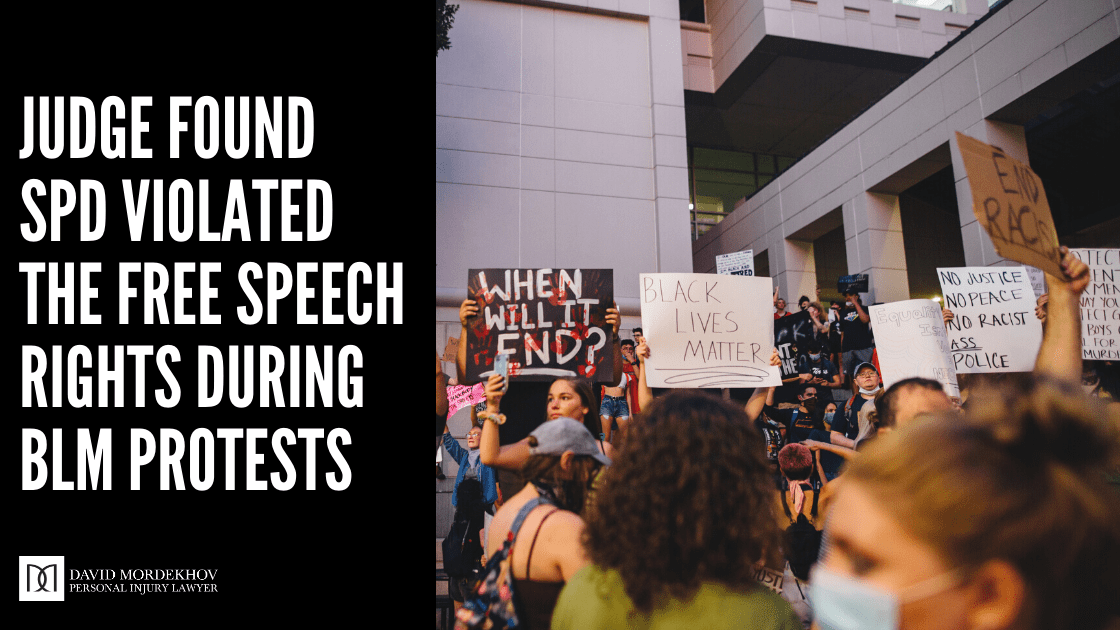The judge found SPD violated the free speech rights during BLM protests

“Not all protestors seek destruction; not all officers seek violence.”
The U.S. District Judge Jones
Over the last three weeks, Seattle encountered an unprecedented wave of protests in response to the murder of George Floyd. The demonstrations continue to this day. This crisis left many of us struggling to make sense of what happened, how we got here, and where we go next.
Last Friday, June 12, 2020, the U.S. District Judge Richard Jones entered an order in the Black Lives Matter v. City of Seattle case addressing the SPD’s use of force during the current Black Lives Matter protests in Seattle.
In this post, we will review Judge Jones’ decision, as it explores the balance between people’s constitutionally protected right to peacefully protest government officials versus legitimate government concerns for public safety and law enforcement.
Timeline
On May 25, 2020, George Floyd was murdered in Minneapolis. For nearly nine minutes, a police officer pressed his knee into George Floyd’s neck, as he struggled to breathe, while other officers held his legs or stood by, watching as he began to die. “please, please, please, I can’t breathe!”, were his last words.
Four days later, on May 29, protests in Seattle began. Thousands have taken to the streets to protest against systemic racism and police brutality. While the protests have been largely peaceful, some bad actors engaged in violence. By mid-day Sunday, May 31st, hundreds of buildings and businesses were damaged. 8 cars were burned and additional vehicles were damaged; multiple injuries reported. Officers confronted arsons, assaults, as well as wide-spread looting and property destruction.
Beginning May 31, 2020, the demonstration focus shifted to the Seattle Police Department East Precinct. For the next 10 days, SPD set up barriers around the East Precinct perimeter, and on multiple occasions deployed tear gas, pepper spray and blast balls in exchange for bottles, rocks, fireworks, and laser pointers.
On June 8, SPD opened the area around the East Precinct for demonstrators, boarding up the precinct and reducing police presence in the area, as an exercise in de-escalation. As of June 8, the area was declared a Capitol Hill Autonomous Zone (CHAZ).
Constitutional protections: The First and Fourth Amendment Rights
The First Amendment protects freedom of speech and freedom of assembly. It includes demonstrations, protest marches, and picketing. Taking to the streets to protest police brutality is at the core of what the First Amendment was designed to protect.
“The test is whether the police acts chilled or silenced an ordinary person from future First Amendment Activities”.
The Fourth Amendment guarantees the person’s right to be free from excessive force. At the same time, the city has a legitimate interest in quickly dispersing and removing lawbreakers with the least risk of injury to police and others. The reasonableness of the particular use of force is judged from the perspective of a reasonable officer on the scene, not with “the 20/20 vision of hindsight.”
“When used, force must be reasonable, proportionate and necessary to what the law enforcement officer encounters.”
Lawsuit
On June 9, 2020, attorneys for the American Civil Liberties Union of Washington representing Black Lives Matter Seattle-King County filed a lawsuit captioned BLM et. al. v. The City of Seattle, et. al. in federal court against the City of Seattle and SPD alleging police misconduct. The lawsuit accused SPD of indiscriminately using excessive force against protesters, legal observers, journalists, and medical personnel. SPD hit protesters with batons and shot them with rubber bullets, released chemical irritants, and thrown “blast balls” and flash-bang grenades into crowds, often with little or no warning. Along with filing the lawsuit, BLM filed a Motion for a Temporary Restraining Order (TRO), asking the court to stop the City from targeting protesters with blast balls, and canisters of gas and pepper spray.
The City opposed the motion arguing that SPD has a legitimate interest in protecting public and officer life and safety, as well as the need to protect public and private property. And that SPD’s actions should be viewed in the context the harm the officers faced, including the burning of police vehicles, attempts to burn police headquarters, injuries to demonstrators and police officers alike, destruction of private businesses, and looting. Additionally, the department had intelligence from the FBI and DHS of credible threats to destroy the East Precinct and other buildings in Seattle.
Ruling
In his last Friday’s Order, Judge Jones recognized the difficulty in drawing an enforceable line that permits police officers to use appropriate means in response to violence and destruction of property but that also does not chill free speech or abuse those who wish to exercise it. But testimonial and video evidence establish that SPD likely violated the protesters’ First and Fourth Amendment Rights. He granted BLM’s Motion for TRO, enjoining SPD for 14 days from employing chemical irritants or projectiles against persons peacefully engaged in protest.
He wrote that the use of indiscriminate weapons against all protesters — not just the violent ones — supports the inference that SPD’s actions were motivated by the protesters exercising their First Amendment Right:
“The proper response to potential and actual violence is for the government to ensure an adequate police presence, and to arrest those who actually engage in such conduct, rather than to suppress legitimate First Amendment conduct as a prophylactic measure.”
Collins v. Jordan, 110 F.3d 1363 (9th Cir. 1996)
You can read Judge Jones’ full 12-page order here.


